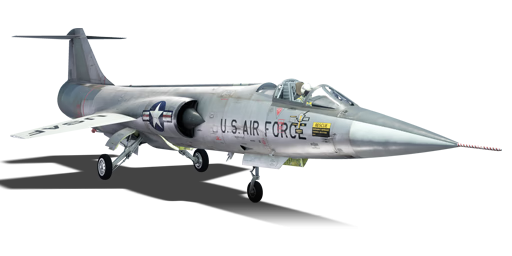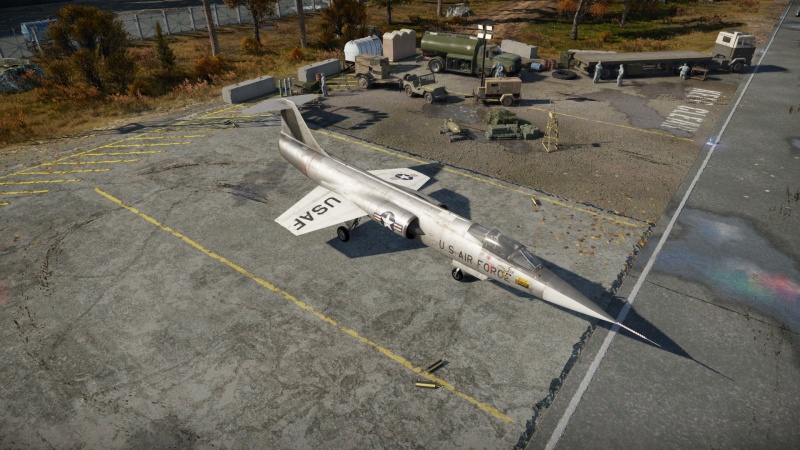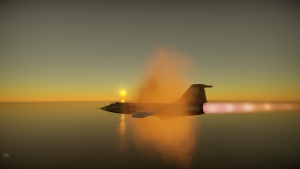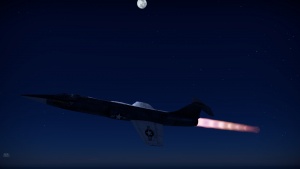Difference between revisions of "F-104A"
(Updated format) |
(→History) (Tag: Visual edit) |
||
| Line 177: | Line 177: | ||
== History == | == History == | ||
<!-- ''Describe the history of the creation and combat usage of the aircraft in more detail than in the introduction. If the historical reference turns out to be too long, take it to a separate article, taking a link to the article about the vehicle and adding a block "/History" (example: <nowiki>https://wiki.warthunder.com/(Vehicle-name)/History</nowiki>) and add a link to it here using the <code>main</code> template. Be sure to reference text and sources by using <code><nowiki><ref></ref></nowiki></code>, as well as adding them at the end of the article with <code><nowiki><references /></nowiki></code>. This section may also include the vehicle's dev blog entry (if applicable) and the in-game encyclopedia description (under <code><nowiki>=== In-game description ===</nowiki></code>, also if applicable).'' --> | <!-- ''Describe the history of the creation and combat usage of the aircraft in more detail than in the introduction. If the historical reference turns out to be too long, take it to a separate article, taking a link to the article about the vehicle and adding a block "/History" (example: <nowiki>https://wiki.warthunder.com/(Vehicle-name)/History</nowiki>) and add a link to it here using the <code>main</code> template. Be sure to reference text and sources by using <code><nowiki><ref></ref></nowiki></code>, as well as adding them at the end of the article with <code><nowiki><references /></nowiki></code>. This section may also include the vehicle's dev blog entry (if applicable) and the in-game encyclopedia description (under <code><nowiki>=== In-game description ===</nowiki></code>, also if applicable).'' --> | ||
| − | The F- | + | The brainchild of famed Lockheed Engineer Clarence “Kelly” Johnson, after having spoken to USAF pilots about their experience in the Korean Air War, the F-104 Starfighter was innovative in both its design and speed. Developed from the start as a daytime air-superiority fighter with speed in mind, the Starfighter began life at Lockheed’s famous “Skunk Works” facility in 1952 to combat the Soviet’s new age of supersonic jet fighters. The aircraft would incorporate the smallest airframe, combined with the most technologically advanced turbojet at the time, to create the base of what would become the F-104. |
| + | |||
| + | In 1953, the USAF showed interest in the project, and proposed an open contest with Lockheed and multiple other firms for a supersonic interceptor, based wholly on performance. Lockheed evidently won the contest and approval for two prototypes to be produced and, in February of 1954, took flight for the first time. Although it was slated to be fitted with the General Electric J79 turbofan, due to shortages of the engines the prototypes were mated to a license-built variant of the British Armstrong Siddley Sapphire engine, called the Wright XJ65-W-6, until the initial power-plant was available. The aircraft however was not without its problems, resulting in a four-year long developmental period for the aircraft. By the end of it, 17 pre-production YF-104As had been built, tested, and used to iron out any problems that would be noticeable on the final F-104. In 1958, the F-104 would finally be available for deliveries featuring some differences from the initial prototypes in the form of a longer fuselage as well as the fitting of General Electric J79GE-3 engines putting out a whopping 14,800lbs of thrust. | ||
| + | |||
| + | From the start the F-104A smashed records, taking the record as the first operational fighter in service to succeed Mach 2, as well as going on to take the records for both altitude and speed in both the F-104A and F-104C variants respectively. On May 7th, 1958, Maj. Howard C. Johnson, in his F-104A, set a new world altitude record at 91,243 feet, and 11 days later another aircraft set a new speed record at 1,403.19mph. The altitude record was later bested by another variant of the aircraft, the F-104C, at a whopping altitude of 103,389 feet. In the 1950’s, the aircraft had come to be exactly what the public had expected a fighter of this magnitude to look like. With a long, pencil shaped fuselage with short, sharp edged wings it encompassed the era of space flight and Sci-Fi with its design. The wings were one of the most unique parts of the aircraft, as well as its long fuselage taken up mostly by its large engine and fuel storage, and were only 4 inches and its thickest. Sweeping was only utilized on the leading edge, and a slight anhedral was in place to combat “Dutch Roll”, a phenomenon where the aircraft rocks side-to-side uncontrollably. The wings, while helping with supersonic flight, were harmful to ground crews, and special equipment had to be issued to service these areas. | ||
| + | |||
| + | While having a history of accidents a high pilot attrition, the aircraft was fitted with an ejection seat. Due to the great speed of the aircraft at Mach 2, it was believed that the seat wouldn’t have enough time to clear the tail section in an ejection scenario. Therefore, a downward firing ejection seat known as the Stanley C-1 was fitted into early models of the F-104. While a good idea, and in theory could work, the C-1 was also believed harmful in the case of a low-altitude ejection of the aircraft. After a failed introduction of the Stanley C-2 ejection seat, the problem was finally solved by the introduction of the Martin-Baker ejection system, particularly in foreign-operator's Starfighters. Roughly 153 F-104As were produced, with 26 more being F-104B two-seat variants. The F-104A spend a short time in USAF service before being send to Air National Guard (ANG) units, which some others being sent to foreign operators which had some success in their service. The first combat of the F-104 however wouldn’t be seen until the Vietnam War, and while not having any kills to count was successful in keeping MiGs back and from intercepting friendly aircraft. The aircraft had a short service life in this theater, only serving in 1965, and again from 1967-1969 until the introduction of the more-capable F-4 Phantom II in which it was replaced by. | ||
== Media == | == Media == | ||
| Line 195: | Line 201: | ||
* ''links to approximate analogues of other nations and research trees.'' --> | * ''links to approximate analogues of other nations and research trees.'' --> | ||
''Links to the articles on the War Thunder Wiki that you think will be useful for the reader, for example:'' | ''Links to the articles on the War Thunder Wiki that you think will be useful for the reader, for example:'' | ||
| + | |||
* ''reference to the series of the aircraft;'' | * ''reference to the series of the aircraft;'' | ||
* ''links to approximate analogues of other nations and research trees.'' | * ''links to approximate analogues of other nations and research trees.'' | ||
| Line 203: | Line 210: | ||
* ''encyclopedia page on the aircraft;'' | * ''encyclopedia page on the aircraft;'' | ||
* ''other literature.'' --> | * ''other literature.'' --> | ||
| + | === Bibliography === | ||
| + | |||
| + | * Military Factory - Lockheed F-104 Starfighter: [https://www.militaryfactory.com/aircraft/detail.asp?aircraft_id=113 website] | ||
| + | * Winchester, Jim - American Military Aircraft: A Century of Innovation - p.238-239 - 1, October 2017: [https://www.amazon.com/American-Military-Aircraft-Innovation-Aviation/dp/1782743197 website] | ||
=== References === | === References === | ||
Revision as of 06:49, 8 January 2021
| This page is about the jet fighter F-104A. For other versions, see F-104 (Family). |
Contents
Description
The F-104A Starfighter is a rank VI American jet fighter with a battle rating of 9.7 (AB/SB) and 9.3 (RB). It was introduced in Update "Starfighters".
General info
Flight performance
The F-104s are generally very fast and the F-104A is no exception. Even when it is stock the climb rate can be comparable to that of both the MiGs and the Phantoms. Its max speed of 2,079 km/h is just as good if not better than other top-tier jets. The acceleration of the F-104A is amazing so even when you are at low speeds it can quickly gain back the lost energy. However, the jet's manoeuvrability leaves much to be desired. Although it can out-turn other jets at its BR it can only do so when it is going above mach 1, at low speeds any other top-tier jets can easily out-turn you.
| Characteristics | Max Speed (km/h at 10,668 m) |
Max altitude (metres) |
Turn time (seconds) |
Rate of climb (metres/second) |
Take-off run (metres) | |||
|---|---|---|---|---|---|---|---|---|
| AB | RB | AB | RB | AB | RB | |||
| Stock | 2,104 | 2,079 | 18900 | 32.4 | 33.0 | 190.9 | 182.9 | 1,180 |
| Upgraded | ___ | ___ | __._ | __._ | __._ | __._ | ||
Details
| Features | |||||
|---|---|---|---|---|---|
| Combat flaps | Take-off flaps | Landing flaps | Air brakes | Arrestor gear | Drogue chute |
| X | ✓ | ✓ | ✓ | ✓ | ✓ |
| Limits | ||||||
|---|---|---|---|---|---|---|
| Wings (km/h) | Gear (km/h) | Flaps (km/h) | Max Static G | |||
| Combat | Take-off | Landing | + | - | ||
| 0 | 546 | N/A | 833 | 444 | ~12 | ~5 |
| Optimal velocities (km/h) | |||
|---|---|---|---|
| Ailerons | Rudder | Elevators | Radiator |
| < 720 | < 950 | < 800 | N/A |
Engine performance
| Engine | Aircraft mass | ||||||
|---|---|---|---|---|---|---|---|
| Engine name | Number | Basic Mass | Wing loading (full fuel) | ||||
| General Electric J79-GE-3 | 1 | 6,182 kg | 513 kg/m2 | ||||
| Engine characteristics | Mass with fuel (no weapons load) | Max Takeoff Weight | |||||
| Weight (each) | Type | 10m fuel | 20m fuel | 30m fuel | 35m fuel | ||
| 1,750 kg | Afterburning axial-flow turbojet | 6,947 kg | 7,712 kg | 8,477 kg | 8,859 kg | 24,000 kg | |
| Maximum engine thrust @ 0 m (RB / SB) | Thrust to weight ratio @ 0 m (WEP) | ||||||
| Condition | 100% | WEP | 10m fuel | 20m fuel | 30m fuel | 35m fuel | MTOW |
| Stationary | 3,936 kgf | 6,061 kgf | 0.87 | 0.79 | 0.71 | 0.68 | 0.25 |
| Optimal | 3,936 kgf (0 km/h) |
7,751 kgf (1,200 km/h) |
1.12 | 1.00 | 0.91 | 0.87 | 0.32 |
Survivability and armour
In terms of armour, there is no armour on the F-104A. Since the F-104A relies on high speed, it wouldn't need armour as that would reduce the speed and manoeuvrability of the plane. The F-104A is a very long plane and it is not very manoeuvrable, making it a large, easy target for enemy guns. As such, the only characteristic that should be relied upon for survivability is the plane's speed. It is very quick, and as such is hard to catch. Of course, it's not quicker than a missile!
- No armour
- Self-sealing fuel tanks
Modifications and economy
Armaments
Offensive armament
The F-104A is armed with:
- 1 x 20 mm M61 cannon, chin-mounted (750 rpg)
Suspended armament
The F-104A can be outfitted with the following ordnance:
- Without load
- 2 x AIM-9B Sidewinder missiles
Usage in battles
The F-104A is a high speed, high altitude fighter-bomber/interceptor. It performs well in high altitude flights meant to intercept fighters and mainly bombers at high altitudes. When the F-104A is fighting at low altitudes with a slower plane, the pilot should consider a hit and run technique to out-speed and return to the target to avoid getting shot back. If you need to turn, be sure to extend your combat flaps as they significantly decrease your turn time.
The F-104A has a decent stock turn time of 33 seconds which is the average or decent turn time of most supersonic jets at rank VI for Russian jets. The F-104A will have difficulties when trying to hit an enemy less than 1 or 2 kilometers away using the 20mm M61 cannon since this cannon will take some time to warm-up before shooting and turn fights will also be difficult due to high speed manoeuvres causing an average 8 or more Gs rendering the pilot unconscious for most of the time.
Using the F-104A's M61 cannon against helicopters would be very easy since they're slow and most of the time are in constant direction and speed, while you are attacking from the side or back with speeds almost or higher than mach 1, the helicopter won't notice until you strafe at them.
Unfortunately, the AIM-9B sidewinder missiles the F-104A carries are lacking at its BR. Most other jets at top tier have much better air-to-air missiles which travel, lock and turn better than the AIM-9B. Therefore, they should only be used in situations where they cannot effectively turn or dodge, or don't know its coming.
The F-104A isn't carrying any flares, so you would have to rely on the planes decent manoeuvrability, and high speed, and maybe turn off the afterburner and maybe even the engine to reduce the incoming AAMs chance to hit the plane. Always remember the insane climb rate for the plane, this means you can also face the incoming AAM at the sun even when the sun is at a steep angle. This in turn would spend more fuel since you would need to use afterburners to efficiently climb at steep angles, out-running short-range anti-air missiles are tricky since some go mach 1.7, while others go mach 2.5, do not expect all missiles to be outrun.
Pros and cons
Pros:
- Good top speed for its rank
- Great rate of climb; even the F-4 Phantom may struggle to match it
- Decent high-speed manoeuvrability, in spite of its tiny wings
- 20 mm Vulcan gun can really do some serious damage
- Good roll rate for a jet
Cons:
- Lousy low-speed manoeuvrability
- Only one secondary weapon load
- Can't carry bombs
- Relatively low ammo count for the Vulcan; trigger discipline is necessary
- M61 Vulcan doesn't shoot instantly, takes less than a second to rotate
- No flares to counter AAMs
- As with most jets, it tends to bleed off speed quickly in sustained turns
- AIM-9B Sidewinder missiles are inadequate compared to other AAMs at top tier
History
The brainchild of famed Lockheed Engineer Clarence “Kelly” Johnson, after having spoken to USAF pilots about their experience in the Korean Air War, the F-104 Starfighter was innovative in both its design and speed. Developed from the start as a daytime air-superiority fighter with speed in mind, the Starfighter began life at Lockheed’s famous “Skunk Works” facility in 1952 to combat the Soviet’s new age of supersonic jet fighters. The aircraft would incorporate the smallest airframe, combined with the most technologically advanced turbojet at the time, to create the base of what would become the F-104.
In 1953, the USAF showed interest in the project, and proposed an open contest with Lockheed and multiple other firms for a supersonic interceptor, based wholly on performance. Lockheed evidently won the contest and approval for two prototypes to be produced and, in February of 1954, took flight for the first time. Although it was slated to be fitted with the General Electric J79 turbofan, due to shortages of the engines the prototypes were mated to a license-built variant of the British Armstrong Siddley Sapphire engine, called the Wright XJ65-W-6, until the initial power-plant was available. The aircraft however was not without its problems, resulting in a four-year long developmental period for the aircraft. By the end of it, 17 pre-production YF-104As had been built, tested, and used to iron out any problems that would be noticeable on the final F-104. In 1958, the F-104 would finally be available for deliveries featuring some differences from the initial prototypes in the form of a longer fuselage as well as the fitting of General Electric J79GE-3 engines putting out a whopping 14,800lbs of thrust.
From the start the F-104A smashed records, taking the record as the first operational fighter in service to succeed Mach 2, as well as going on to take the records for both altitude and speed in both the F-104A and F-104C variants respectively. On May 7th, 1958, Maj. Howard C. Johnson, in his F-104A, set a new world altitude record at 91,243 feet, and 11 days later another aircraft set a new speed record at 1,403.19mph. The altitude record was later bested by another variant of the aircraft, the F-104C, at a whopping altitude of 103,389 feet. In the 1950’s, the aircraft had come to be exactly what the public had expected a fighter of this magnitude to look like. With a long, pencil shaped fuselage with short, sharp edged wings it encompassed the era of space flight and Sci-Fi with its design. The wings were one of the most unique parts of the aircraft, as well as its long fuselage taken up mostly by its large engine and fuel storage, and were only 4 inches and its thickest. Sweeping was only utilized on the leading edge, and a slight anhedral was in place to combat “Dutch Roll”, a phenomenon where the aircraft rocks side-to-side uncontrollably. The wings, while helping with supersonic flight, were harmful to ground crews, and special equipment had to be issued to service these areas.
While having a history of accidents a high pilot attrition, the aircraft was fitted with an ejection seat. Due to the great speed of the aircraft at Mach 2, it was believed that the seat wouldn’t have enough time to clear the tail section in an ejection scenario. Therefore, a downward firing ejection seat known as the Stanley C-1 was fitted into early models of the F-104. While a good idea, and in theory could work, the C-1 was also believed harmful in the case of a low-altitude ejection of the aircraft. After a failed introduction of the Stanley C-2 ejection seat, the problem was finally solved by the introduction of the Martin-Baker ejection system, particularly in foreign-operator's Starfighters. Roughly 153 F-104As were produced, with 26 more being F-104B two-seat variants. The F-104A spend a short time in USAF service before being send to Air National Guard (ANG) units, which some others being sent to foreign operators which had some success in their service. The first combat of the F-104 however wouldn’t be seen until the Vietnam War, and while not having any kills to count was successful in keeping MiGs back and from intercepting friendly aircraft. The aircraft had a short service life in this theater, only serving in 1965, and again from 1967-1969 until the introduction of the more-capable F-4 Phantom II in which it was replaced by.
Media
- Images
- Videos
See also
Links to the articles on the War Thunder Wiki that you think will be useful for the reader, for example:
- reference to the series of the aircraft;
- links to approximate analogues of other nations and research trees.
External links
Bibliography
- Military Factory - Lockheed F-104 Starfighter: website
- Winchester, Jim - American Military Aircraft: A Century of Innovation - p.238-239 - 1, October 2017: website
References
| Lockheed Corporation | |
|---|---|
| Fighters | XP-38G · P-38E · P-38G-1 · P-38J-15 · Bong's P-38J-15 · P-38K · P-38L-5-LO · YP-38 |
| Bombers | B-34 · PV-2D |
| Jet Fighters | F-80A-5 · F-80C-10 |
| F-104A · F-104C | |
| Strike Aircraft | F-117 |
| Export / License | A-29 · ▄Hudson Mk V |
| ␗P-38L-1 | |
| ␗F-104A · ▀F-104G · ␗F-104G · ▄F-104G · ▅F-104J · ▄F-104S | |
| The Lockheed Corporation merged with Martin Marietta Corporation in 1995 to form Lockheed Martin Corporation. | |
| See Also | SABCA · Mitsubishi Heavy Industries · Fiat Aviation |
| USA jet aircraft | |
|---|---|
| Fighters | |
| F9F | F9F-2 · F9F-5 · F9F-8 |
| F-80 | F-80A-5 · F-80C-10 |
| F-84 | F-84B-26 · F-84F · F-84G-21-RE |
| F-86 | F-86A-5 · F-86F-25 · F-86F-2 · F-86F-35 |
| F-89 | F-89B · F-89D |
| F-100 | F-100D |
| F-104 | F-104A · F-104C |
| F-4 | F-4C Phantom II · F-4E Phantom II · F-4J Phantom II · F-4S Phantom II |
| F-5 | F-5A · F-5C · F-5E · F-20A |
| F-8 | F8U-2 · F-8E |
| F-14 | F-14A Early · ▄F-14A IRIAF · F-14B |
| F-15 | F-15A · F-15C MSIP II · F-15E |
| F-16 | F-16A · F-16A ADF · F-16C |
| Other | P-59A · F2H-2 · F3D-1 · F3H-2 · F4D-1 · F11F-1 |
| Strike Aircraft | |
| FJ-4 | FJ-4B · FJ-4B VMF-232 |
| A-4 | A-4B · A-4E Early |
| A-7 | A-7D · A-7E · A-7K |
| AV-8 | AV-8A · AV-8C · AV-8B Plus · AV-8B (NA) |
| A-10 | A-10A · A-10A Late · A-10C |
| F-111 | F-111A · F-111F |
| Other | A-6E TRAM · F-105D · F-117 |
| Bombers | |
| B-57 | B-57A · B-57B |







